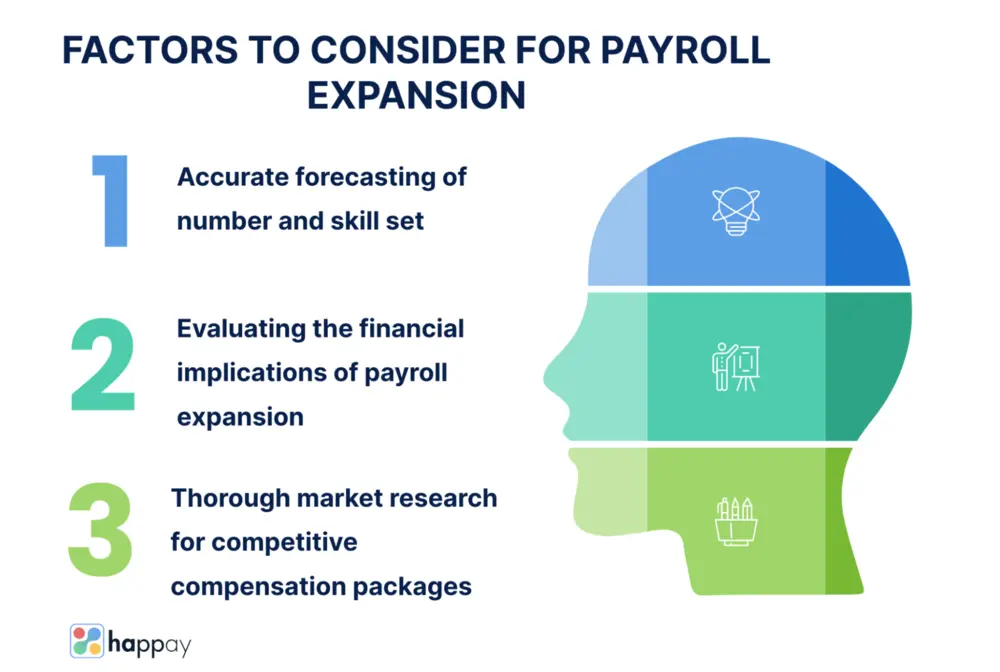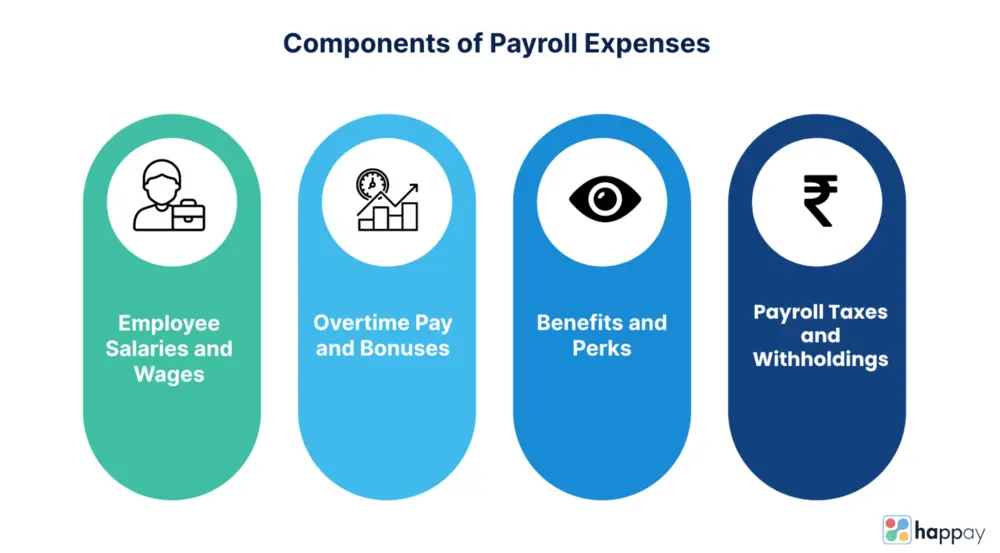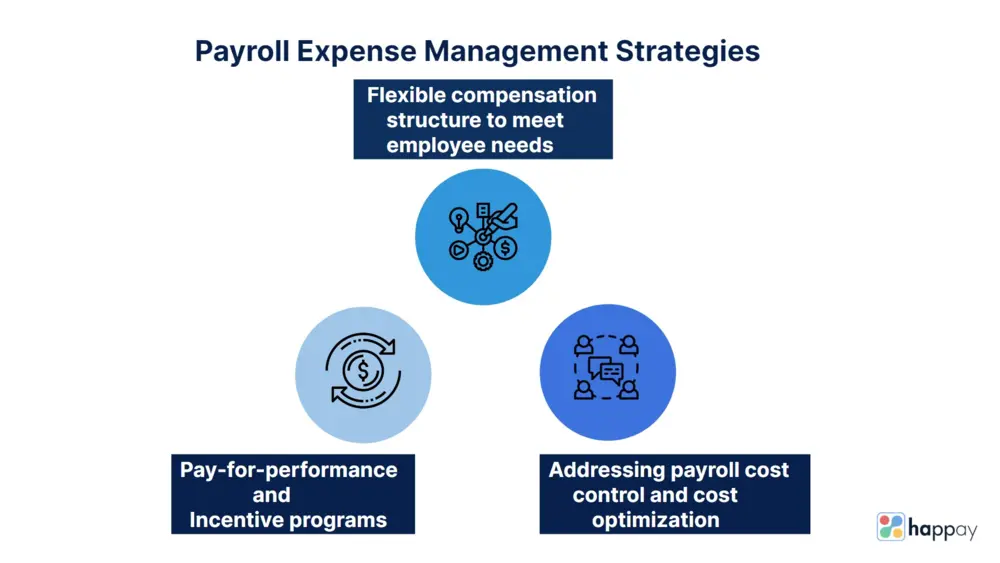Last Updated on November 28, 2025
Introduction to payroll expense
Payroll, the one word with two syllables, is an intrinsic part of any business. Simply put, Payroll = pay the roll (list of employees) means paying employees.
Payroll expenses can account for the lion’s share of your business costs. These are the expenses you incur as an employer for your employees.
Let us understand more about this large chunk of your business expense and how it can significantly impact the company’s growth, financial liability, and profitability.
What are payroll expenses?
Payroll expenses represent all the costs on your part as an employer to compensate your employees. It would go well beyond the regular salaries and gross wages. The umbrella of payroll expenses would include
- Bonuses
- Benefits
- Overtime pay,
- Commissions
- Employee training and development
- Severance pay,
- The Employer-payable portion of the taxes,
- Payroll processing fees.
Payroll expense forms a significant portion of the total operating expense of your business. Across industries, payroll expenses typically range from 20% to 40% of operating costs. It thus becomes a critical financial benchmark used in budgeting and financial reporting of your company.
Quick Read: 10 Best Expense Reporting Software Systems and Tools in 2023
Payroll Expense and Business Growth
Payroll, expense, and business growth are directly linked. The two facets of the business walk hand in hand. Hiring more employees would become imperative as you plan to grow your business. The payroll expense would then naturally increase with the growth of your business.
Payroll expense has various components, which are discussed later in this article. So, an increase in payroll would mean an increase in all these components. You can expect payroll expenses to increase with business growth in these subtle ways.
For example, with business growth, you might have employees working overtime. You will add this overtime to your payroll expenses.
Another example would be the need to upskill existing employees for your new business requirements. The training and development costs again will increase your payroll expense.
An investment in payroll expense becomes inevitable for the growth of your business. Payroll expenses will have to be managed efficiently for a positive impact on the development of your business.
1. The Link Between Employee Compensation and Business Success
As a famous business quote goes, “To win in the marketplace, you must first win in the workplace.”
It can happen only when employees come into work thinking about how they could make a difference to your business. Fair, competitive, and well-crafted compensation is the key for your employees to contribute to your business as if it was theirs.
By offering competitive employee compensation, you can realize other benefits too. These would include better productivity and individual performance, higher employee morale, and increased employee loyalty. It will result in low attrition rates and, thus, lower turnover costs.
You can attract, recruit, and retain top industry talent with attractive and market-correct compensation programs.
A positive environment in the workplace with satisfied employees certainly improves the brand name and reputation of the company.
All the above factors make up the perfect recipe for your business to be successful. Business success is imminent when the business owner and the employee are on the same side of the table.
2. Planning for Payroll Expansion during Company Growth Phases
When you decide to scale your business, it is not a time for the “To do more with less – fewer employees” mindset. The growth phase needs to be accompanied by careful planning for payroll expansion to ensure a smooth transition. You will need to consider the key factors in planning payroll expansion.

- To forecast workforce needs, both in numbers and skill set, to match the growth areas targeted by the company
- To evaluate the financial implications of payroll expansion. Additional costs for, e.g., benefits and other associated costs, for, e.g., training or onboarding costs, will have to be examined and incorporated
- To conduct thorough market research to offer a competitive compensation package. It must be attractive and align with the company’s financial capacity.
Proactively planning your payroll expansion will better equip you with an efficient workforce of your choice to sail through the challenges of the growth phase.
3. Managing Payroll during Market Challenges and Economic Changes
Like we often hear, uncertainty is the only certainty.
Having been in business and gone through various economic cycles, you realize that long-term, things eventually rebound. So, to tide over market challenges and economic changes, you would want to follow the principle of strategic thinking and planning. Managing payroll liabilities during economically challenging times would require careful financial planning, flexibility, and strategic decision-making. It will help steer through uncertain times while motivating the workforce.
Some steps to consider,
- Assessing the current financial statement and capacity of the company to endure payroll expenses
- Plugging holes in spending like non-essential and discretionary spending, without compromising the quality of essential business operations
- Introducing flexible work arrangements like reduced work hours or unpaid leave
- Cutting back on overtime and implementing performance-based incentives for employees to enhance productivity
- Engaging employees to retain valuable talent and offering them programs to support their mental health and well-being during difficult economic times
Maintaining a kind of ‘dual vision’ by addressing today’s realities but keeping an eye on the horizon will help steer through challenging times.
Learn More: How do Companies Manage their Employees’ Remote Work Expenses?
The Benefits of Investing in Payroll Expenses
Investing in Payroll expenses is an investment in human capital which leads to the business’s overall success. Outwardly, Payroll expense may be viewed only as a cost, but it is a long-term investment in the company’s most valuable asset – its employees. A business is as strong as its workforce.
A few significant benefits of investing in Payroll Expense
- Attracts top talent to the company and helps retain experienced employees. It will reduce turnover and training costs and keeps the workforce stable and competent
- Motivate employees to be productive and committed to achieving the company’s goals
- Enhances the company’s image in the marketplace for being a good employer. It can attract top talent and build strong relations with customers and partners
Investing in payroll expenses paves the way to achieve sustainable growth for any business in the long run.
Components of Payroll Expense
Payroll expense includes various components that represent the total cost of compensating employees. Let us look at the various moving parts of the payroll expense.

1. Employee Salaries and Wages
This is the primary component of payroll expense. It represents an employee’s basic salary without including additional incentives and before making any deductions. This amount is taxable.
2. Overtime Pay and Bonuses
Overtime pay is the additional compensation paid to an employee for the extra hours of service rendered. The rates vary for different types of overtime, i.e., overtime on regular work days during daytime/nighttime, overtime on weekends, and holidays.
Bonuses are an additional compensation component added to an employee’s pay as an incentive. It could be a reward for exceptional performance or achieving specific goals. Examples of bonuses are sign-on bonuses, annual bonuses, or seniority bonuses.
3. Benefits and Perks
Employee benefits include health insurance, retirement plans, life insurance, disability coverage, and other fringe benefits you provide. The cost of these is a component of the payroll expense.
Perks are incentives given by the employer. Typical perks are a company car, gym membership, or private healthcare.
4. Payroll Taxes and Withholdings
Employer contributions to health insurance, income taxes, pension fund, unemployment insurance, and other relevant payroll taxes constitute this component of payroll taxes and tax withholdings.
How to Calculate Payroll Expenses?
It would be best to consider all the costs under the various components in calculating payroll expenses. Following is a step-by-step guide to help calculate payroll expenses:
- Identify Employee Compensation Components
List all the applicable elements that are contributing to employee compensation, like employee gross wages, overtime pay, benefits, taxes, etc.
- Collect relevant payroll information
This would include collecting employee names, salaries, hours worked, overtime hours, bonuses, commissions, and any other additional earnings or deductions
- Calculate Gross Pay for each employee
Calculate this by adding base employee wages, overtime pay, bonuses, and commission components.
- Calculate Payroll Taxes
Determine the portion of the payroll taxes paid by the employer. It would include income tax withholding on health insurance, pension fund, and any other applicable taxes paid by the employer.
- Include Employee Benefits
Add the cost of providing employee benefits, like health insurance premiums, retirement plan contributions, and other fringe benefits.
- Include other Payroll costs
Employee expense reimbursements, severance pay, training expenses, etc.
- Total each employee’s Payroll expenses
Add up the total payroll expenses for each employee, including gross pay, payroll taxes, benefits, and other related costs.
- Calculate Total Payroll Expenses
This is the total of all the individual payroll expenses to get the total payroll expense for the company’s workforce.
- Add any Payroll Processing costs
Include costs of using payroll software or outsourcing payroll processing and other related expenses for these services.
- Payroll period
Calculate the payroll expenses for a specific period, whether weekly, bi-weekly, monthly, or annually.
Read More: Business Budgeting: Types, Components and Importance
Calculating and Budgeting Payroll Expenses
Your business’s payroll budget comprises expenses directly related to employees, including gross wages, commissions, and taxes. To create a payroll budget, identify everyone you pay, map their costs, and run payroll.
A payroll budget gives you the total cost of your employees and the specific items that make up the costs. It gives you an insight into segments of your business that are over-resourced or under-resourced. Payroll budgets can also help identify areas of potential savings.
This process will also equip you to make educated decisions regarding growth plans and achieve financial stability in the long run.
1. Understanding Payroll Accounting and Methods
Payroll accounting is the process of recording and managing all the financial transactions involving employee compensation within the company. It focuses narrowly on all the business expenses associated with employees.
Payroll accounting needs to track, record and categorize transactions of all the components of payroll expense.
1.1 Understanding Payroll Accounting
- It gives an accurate view of the cost of each employee and the total cost of all your employees
- Can estimate the incremental cost of each additional employee hired
- Will help decide whether to hire full-time employees, contractors, or part-time hourly workers
- Can help estimate the impact of payroll expenses on the bottom line of the business
1.2 Payroll Accounting Methods
- Manual Payroll Accounting If you are a small business owner or self-employed, payroll accounting may be processed manually using payroll journal entries, paper-based records, or spreadsheets. This method is very laborious, time-consuming, and prone to errors.
- Payroll Software Companies use specialized payroll software to streamline payroll accounting processes. This reduces process time as the software automates calculations, tracks employee data, generates payslips, and helps with tax rate compliance.
- Outsourced Payroll Services Companies outsource their payroll accounting to third-party service providers. These providers are responsible for payroll accounting, including payroll processing, tax withholding, and reporting.
An efficient payroll system ensures employee paychecks are delivered on time and without incurring any tax penalties.
Read more: Budgeting and Forecasting: A Comprehensive Guide
2. Forecasting Payroll Costs and Cash Flow Management
For better or worse, predicting payroll is essential in good times and bad. It is a crucial aspect of a successful business.
Forecasting payroll costs brings the following advantages,
- Helps protect and generate profits
- The company can effectively budget for the coming year
- Ensures the finance is available for employee compensation leading to a productive and effective workforce
- The data can generate valuable insights into the strengths and vulnerabilities of the workforce, which will help strategic decisions
- It helps the company to prepare for the worst conditions in the market proactively
Cash flow management involves tracking and controlling the money coming in and going out of a business. It helps to forecast the cash flow needs of a business accurately. Effective cash flow management strategies help to predict money available to cover debt, payroll, and vendor invoices.
Cash flow management means striking a balance between paying on time and delaying transactions to maintain healthy cash reserves in the business. Timing of inflows and outflows is key in cash flow management.
Essential cash flow management strategies
- Optimizing accounts receivable
- Negotiating favorable payment terms with suppliers
- Managing inventory efficiently
- Establishing cash reserves to cover payroll costs
- Minimizing operating expenses
A managed cash flow can ensure businesses have enough money to pay expenses, debts, and themselves.
3. Creating a Scalable Payroll Budget
All businesses have the common objectives of revenue, profit, and growth.
Your ability to scale and flex according to market conditions is critical to achieving these goals. It translates to your payroll also being capable of scaling and being flexible.
Though workforce costs are a big part of the total business, they are frequently not considered while charting growth strategies.
Projecting growth for your company without considering how you will pay your new employees is never a good idea. It is like walking blindfolded.
Here are the key steps to consider while creating a scalable payroll budget:
- Analyzing historical payroll data: Helps you to understand trends and patterns in payroll expenses
- Identifying scalability factors specific to your organization: These factors could be projected employee headcount growth or potential salary increases
- Forecasting workforce changes: For the company’s growth plans, forecast the expected changes in the size and composition of the workforce and the associated costs
- Estimating salary increase by accounting for market trends, inflation, and changes in the cost of benefits
- Utilizing payroll software that offers scalability features to accommodate workforce changes
Creating a scalable payroll budget ensures that your company can manage payroll expenses effectively as it grows and evolves.
Learn More: 10 Best Business Budgeting Software & Tools for 2023
Payroll expenses examples
Here are the typical examples of payroll expenses:
- Employee wages: This is the regular compensation paid to the employees for their services rendered to the business
- Overtime pay: Additional compensation for the work done by the employee beyond his regular work hours
- Bonuses and Incentives: Payment awarded to the employee for achieving specific goals for the betterment of the business
- Benefits: Cost of providing employee benefits like health insurance
- Severance pay: Compensation given to those employees who are laid off
- Paid Time off: Cost for your company in providing paid vacations, sick leaves, etc. to the employees
- Employee Reimbursements: Expenses reimbursed to employees for business-related expenditures
- Training and Development Costs: The expenses incurred by your company for training programs and employee skill development initiatives
- Employer contributions to retirement plans
- Employer Assistance Programs (EAPs): The cost of offering programs for employee well-being and safety initiative programs
- Uniforms and Work attire: Costs related to providing uniforms in certain industries
Legal Compliance and Employer Obligations
The employer’s relationship with employees is also governed by legal aspects.
Legal compliance involves the process wherein a company adheres to the complex laws, policies, and procedures that regulate business practices in a particular jurisdiction. It is about knowing and understanding the laws that apply to your company and ensuring that the company always complies with them.
Broadly, your company’s legal obligations include provisions and regulations outlined in various labor laws, such as the Minimum Wages Act, Payment of Bonus Act, Employees’ Provident Fund, and Maternity Benefit Act, among others. Payroll compliance is a vital aspect of legal compliance for your company.
Failure to comply and meet these obligations by the company can lead to legal consequences. The business might have to face financial penalties, censures, and reputational damage, and in some cases, the directors might face jail time.
1. Adhering to Labor Laws and Employment Regulations
Today’s workplace is a global and constantly changing one, with new legislation constantly being introduced. Labor laws and employment regulations have evolved over a long period. You must stay abreast of the labor laws and stay compliant. Adhering to labor laws and employment regulations makes you compliant with the current regulations and puts you on the right side of the law.
Labor laws and employment regulations are a collection of legally binding regulations for you to follow mandatorily. There are two sides to this coin. On the one side, they are enforced to safeguard the rights of the employees and protect them from exploitation. The laws ensure fair wages and decent working conditions across industries.
On the other side, they also provide critical benefits for your business.
One major benefit of adhering to labor laws and employment regulations is creating a level playing field. Without such regulation, some companies could take undue advantage of their workforce, like putting them through extra grueling hours without proper remuneration and working conditions.
It would wrongly put them at a competitive advantage in the marketplace compared to companies like yours who follow best practices for the employees. Enforcing labor laws gives every business owner an equal opportunity and creates a better business environment.
Adhering to labor laws and employee regulations creates happy workers. Happy workers are directly linked to increased productivity. They tend to produce a higher quality of work, increasing your business’s bottom line.
Also, having clear policies regarding working hours, sick leaves, etc., thins down the administrative paperwork to be processed. Adherence to labor laws will also shield you from any legal disputes and paying hefty fines.
Ultimately being compliant with labor laws and employee regulations will work beneficially for you and your employees and help create a fairer business environment.
2. Payroll Tax Reporting and Remittance
Payroll taxes are the taxes you withhold from each of your employee’s salaries as an employer. It includes gross income, wages, perks, or any other compensation paid to your employees. It is the tax deducted at source (TDS) and will have to be remitted to the government by you.
The employee can claim tax-free deductions such as house rent allowance, leave travel allowance, etc. These would be included while calculating the employee’s taxable income and payroll tax.
As an employer, you must also contribute to the payroll tax too. It would include the company’s contributions towards employee benefits like insurance programs, pension plans, gratuity, etc. Your portion of the payroll tax is directly related to employing a worker. It can be a fixed charge or proportionally linked to a worker’s salary.
Payroll tax reporting involves calculating and documenting the payroll taxes you and the employees owe. Payroll tax remittance involves submitting the relevant tax forms and payroll taxes to the appropriate tax authorities in the timeline defined by your payroll schedule.
The responsibility of remitting the payroll taxes is yours. Non-paying payroll taxes on time will attract heavy payroll tax penalties for you. You may also be required to face interest rates.
You could face prosecution by not filing taxes on time, as you represent the company.
Governments use revenues from payroll taxes to fund specific programs like healthcare, worker’s compensation, etc. It also goes towards local governments maintaining and improving infrastructure and services.
Remittance of payroll taxes aids in technological advancements and other areas of the country’s development. It helps set up a thriving business environment and improves the ease of doing business.
3. Compliance with Employee Benefits and Entitlements
Are you wondering what benefits you must provide your employees as an employer?
Well, there are two kinds of employee benefits,
- Statutory benefits, which are a set of rights and privileges to which employees are entitled
- Discretionary benefits, which are fringe benefits given to the employees at your discretion
Statutory benefits can include gratuity payment, health insurance, maternity leave, provident fund, minimum wages, and mandatory leave.
The statutory benefits depend on where you operate. For example, in the USA, social security taxes (fica tax), federal unemployment taxes (futa), and Medicare taxes are mandatory under federal and state income tax laws.
Discretionary benefits can vary over a wide range from disability insurance to tuition reimbursement to paid vacation time to paid gym membership.
Statutory benefits are mandatory by law; as the name suggests, discretionary benefits are those you provide at your discretion.
If you neglect to offer statutory benefits for your employees, it can result in fines, penalties, imprisonment, and potential legal action from the affected employees. Also, compliance with employee benefits regulations is critical for expanding your workforce.
By complying with the laws that govern employee benefits and entitlements, you would be in the government’s good books and be able to focus on growing your business rather than be bogged down by regulatory breaches or legal hassles.
Learn More: Financial Planning: What is it, Types, Objectives, Steps & Benefits
Payroll Expense Management Strategies
We now understand that your payroll expense is the most considerable expense you incur in running the business. This expense is tied directly to your indispensable human resource capital.
Adopting some well-thought strategies will allow you to manage payroll expenses more efficiently.
Here are a few tried and tested strategies adopted globally.

1. Pay-for-Performance and Incentive Programs
You can never underestimate the power of money and incentives in improving employee motivation. Employees feel assured that the company will acknowledge their hard work and dedication. It will motivate them to put in their personal best. It will make it possible for you to build engagement and employee financial wellness in the workplace.
Pay-for-performance and incentive programs pay an employee based on meeting specific performance targets or for high-quality work. These payments can either increase the base pay or a bonus added to a fixed base pay.
It acts as an effective tool for managing your payroll expense. You end up paying more to only the targeted high-performing employees driving your growth.
Enhancing these schemes can encourage better performance and promote a performance-driven culture within the organization.
2. Flexible Compensation Structures to Meet Employee Needs
With an organization’s global and diverse workforce, ‘Let’s Get Flexible’ is the new buzzword about employee compensation structure.
This concept describes a compensation package in which your employees decide how much they receive as their net pay. The employee portion of the cost to the company (CTC) can be modified.
Companies now offer flexible benefits, like driver allowance, broadband, meal vouchers, gym membership, etc., so employees can choose programs that work for them.
The employees are more in control of the cash component of their salary, leaving them more satisfied.
This Flexi pay structure is an excellent strategy for managing your payroll expenses. You could lower your payroll tax by showing an additional payroll debit to cover the costs of the benefits you offer. It is a win-win for the employee and you.
3. Addressing Payroll Cost Control and Cost Optimization
You need your business to grow but are under constant pressure to cut costs and maximize performance. Fortunately, you have options for reducing payroll expenses without compromising growth.
- Outsourcing some activities to contractors can save money on payroll. You will not have to pay their payroll taxes or be required to offer them any statutory benefits. Contractors do not qualify for any bonuses or severance packages. You can hire contractors for only the period necessary.
- Overtime pay is costly for your business. Design work schedules and scope to reduce or eliminate overtime.
- Offer flexible working hours for employees. They can work when they are most productive.
- Automate and integrate payroll systems. It will reduce processing time, reduce human errors and eliminate compliance issues.
Read More: Cost Control: Definition, Techniques, Methods, Strategies & Examples
Leveraging Payroll Software and Technology
Payroll processing is considered a non-core but daunting task.
To process payroll in-house, your HR team must manage onboarding, vendors, leave and attendance, employee benefits, expenses, and other administrative tasks. And if you have a global workforce, staying in tune with the ever-changing regulations and labor laws across the countries gets further complicated.
Expecting your HR team to manually process error-free payroll can become overwhelming. Investing in well-integrated and advanced payroll software is the need of the hour.
Benefits of Automated Payroll Systems
The automated payroll system is a software system that automatically completes payroll processing instead of the tedious manual process.
The benefits are multi-fold
- Higher efficiency with lower costs: Automated payroll is error-free and quick compared to manual systems. The larger your organization, the larger the data to handle and the more calculations. It does become impossible to deal with even multiple payroll specialists. A payroll automation system can do this in a fraction of the time
- Reduced risk of human error: It’s human to err. The probability of the payroll team making accidental mistakes manually is way higher than the automated system
- Timely payroll processing: Faster and more accurate payroll processing results in employees getting their paychecks on time, every time
- Greater information security: A secure, central location maintains the employee information where only concerned people access it
Integrating Payroll Software with HR and Accounting Systems
Integrating Payroll software with HR and accounting systems means syncing your payroll data into your accounting system. Several of your related stand-alone systems will merge into one system.
It simply means that you let the same provider handle associated functions such as time and attendance, expenses, pension funds, and insurance premiums. By this integration of payroll with other procedures, you can avoid entering the same data over and over again. It will dramatically reduce errors and accounting time.
Other benefits of this unified system are,
- Data integration – You can monitor all your financial operations in real-time. Data integration will help you budget effectively. It will also help deliver better data reporting to all the stakeholders of your company
- Data is easily accessible – You can provide employees with flexible working hours and locations. Since data is easily accessible, it will be possible to track it effortlessly
Data Security and Confidentiality Concerns
An integrated payroll system will be more secure than a payroll journal entry or spreadsheet-based manual system. It is because every change you make is transparent. Any change made in the data will generate an email to all the parties concerned. Furthermore, the system will show who has changed the data and when. This feature will help you identify and prevent fraud.
Sensitive, confidential employee information is stored in one centralized location accessed by only authorized personnel and is often cloud-based. It is easier to guarantee data security and privacy. Data is less likely to be duplicated and readily available to all stakeholders.
Best Payroll Expense Software
We know now that automation best manages payroll expenses. Well, there is no shortage of options available in the marketplace. However, you must choose software that will provide the best solution for your organization.
Here we look at five well-rated payroll software available in the market
- RUN Powered by ADP (RUN) caters to small business owners: It makes payroll quick and easy. You could choose from basic payroll to a full suite of HR tools and services.
- Gusto: Whether your business is kick-starting or scaling, Gusto provides payroll and modern HR solutions.
- Rippling: Rippling provides a single global system to help you manage and automate every aspect of the employee lifecycle.
- Paylocity: It is an all-in-one software platform for HR. They work with you to identify the best solution for your business.
- Remote: No matter what the size of your company is, Remote empowers you to manage your full-time or contract workers worldwide.
Many payroll software provides a free trial and demonstration. It would help confirm that you have the best solution for your business needs.
Read More: 10 Best Human Resources (HR) Software
Advantages and disadvantages of payroll expense
There is no ideal system in the world. Positive and negative aspects are two sides of the same coin, which means that payroll expense systems come with their bundle of advantages and disadvantages. It is up to you to decide if the advantages outweigh your business requirements.
Few advantages:
- Time-saving process
- Reduces errors caused by manual interventions
- Cost cutting as a streamlined HR is sufficient
- Helps to store and track employee data
- Easier to maintain compliance with regulations
Few disadvantages:
- The cost of the payroll system can be a burden on your budget if you are a small business owner or are just starting
- You need to enforce data protection regulations strictly otherwise, confidentiality threats may create issues for you.
- You and the provider need to overcome coordination challenges
Best Practices for Efficient Payroll Expense Management
It is always better to set up an automated payroll management system for any size of your business. You can manage your business payroll using the best practices of a payroll management system.
Some of the best practices are:
- Classify your employees for payroll management (e.g., permanent, contractor, or daily wage) and define a policy for payroll calculation of each type of employee
- Use an integrated payroll management system
- Confirm accurate data transfer to payroll from integrated systems
- Audit all your processes regularly
Read More: 8 Best Payroll Software for your Business in 2023
How does Happay help in expense management?
Manual expense management in its traditional form is a snail-paced process. It brings to mind an image of employees shoveling through small pieces of paper stuffed into their wallets and handbags collected over a month to look for relevant receipts to fill the reimbursement request. With project deadlines and other responsibilities, this is the last thing you want your already stressed employee to do.
Happay prepaid cards are a more innovative and accessible way to cash wages. Employees will have access to salary, and there is no need for a bank account. Happay cards link to Happay’s cloud-based expense management software; any mobile or web service can control it. Employee expense management will become streamlined. It makes employee’s life easier, and you get total control by being able to fund or block cards on the fly, track card expenses in real time, set limits for spending, and approve expenses on the go.
Conclusion
Payroll expense, the most significant part of your operating expense, constitutes your employees’ total salaries. It is a necessary expense as it is the one that makes the wheels of your business turn.
As is evident, it becomes very crucial for you to manage payroll expenses efficiently using the strategies discussed in this article.
Employee morale and performance will increase with good comprehensive pay packages. It will ultimately result in higher productivity, lower turnover, and foster a positive work environment. These factors will work towards making your business successful. Payroll expenses, though they feel like a burden at the outset, can be strategically used to script the growth of your business.
FAQs
A payroll cost journal entry is a bookkeeping method of recording the payroll expenses in the company’s general ledger. It helps document the payroll expenses of the employees.
Yes, payroll and other payroll expenses are one of the journal entries.
Simply put, payroll is the process of paying employees in a business, i.e., the total amount of money an employee receives from an employer. Whereas expenses encompass all the expenditures of running a business. It would include payroll along with other expenses.
A company’s payroll represents all the employees employed. Being on the company’s payroll means being paid by them for services rendered.
Payroll expenses are costs incurred by an organization in employing workers, paying their compensation, all taxes, and other employment costs for which the employer is responsible.










Discussion about this post